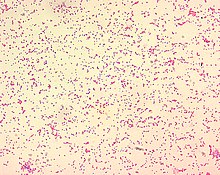| Brucella ceti | |
|---|---|
| Scientific classification | |
| Domain: | Bacteria |
| Phylum: | Pseudomonadota |
| Class: | Alphaproteobacteria |
| Order: | Hyphomicrobiales |
| Family: | Brucellaceae |
| Genus: | Brucella |
| Species: | B. ceti
|
| Binomial name | |
| Brucella ceti Foster et al. 2007
| |
Brucella ceti is a gram negative bacterial pathogen of the Brucellaceae family that causes brucellosis in cetaceans. Brucella ceti has been found in both classes of cetaceans, mysticetes and odontocetes.[1] Brucellosis in some dolphins and porpoises can result in serious clinical signs including fetal abortions, male infertility, neurobrucellosis, cardiopathies, bone and skin lesions, stranding events, and death.[1]
Brucella ceti was first isolated in 1994 when an aborted dolphin fetus was discovered.[2] Only a small portion of those with Brucella ceti have overt clinical signs of brucellosis indicating that many have the bacteria and remain asymptomatic or overcome the pathogen. Serological surveys have shown that cetacean brucellosis may be distributed worldwide in the oceans. The likely transmission route for the bacterial pathogen in cetaceans is through mating or reproduction and lactation.[1] Brucellosis is a zoonotic disease: marine mammal brucellosis can infect other species, including human beings.

- ^ a b c Guzmán-Verri C, González-Barrientos R, Hernández-Mora G, Morales JA, Baquero-Calvo E, Chaves-Olarte E, Moreno E (2012). "Brucella ceti and brucellosis in cetaceans". Frontiers in Cellular and Infection Microbiology. 2: 3. doi:10.3389/fcimb.2012.00003. PMC 3417395. PMID 22919595.
- ^ Garofolo G, Zilli K, Troiano P, Petrella A, Marotta F, Di Serafino G, Ancora M, Di Giannatale E (February 2014). "Brucella ceti from two striped dolphins stranded on the Apulia coastline, Italy". Journal of Medical Microbiology. 63 (Pt 2): 325–9. doi:10.1099/jmm.0.065672-0. PMID 24324028.